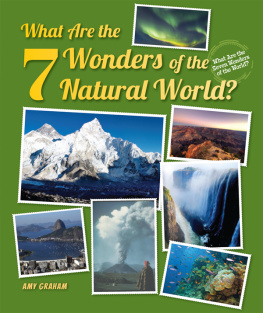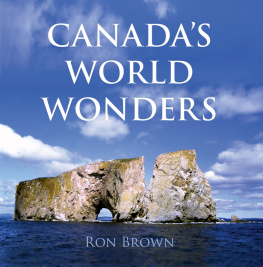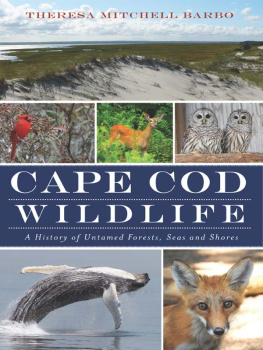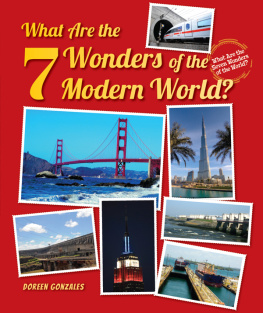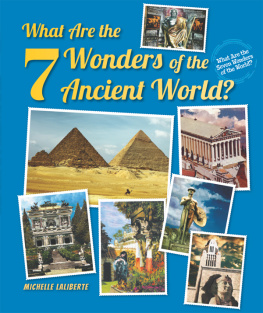Amy Graham - What Are the 7 Wonders of the Natural World?
Here you can read online Amy Graham - What Are the 7 Wonders of the Natural World? full text of the book (entire story) in english for free. Download pdf and epub, get meaning, cover and reviews about this ebook. year: 2013, publisher: Enslow Publishers, genre: Children. Description of the work, (preface) as well as reviews are available. Best literature library LitArk.com created for fans of good reading and offers a wide selection of genres:
Romance novel
Science fiction
Adventure
Detective
Science
History
Home and family
Prose
Art
Politics
Computer
Non-fiction
Religion
Business
Children
Humor
Choose a favorite category and find really read worthwhile books. Enjoy immersion in the world of imagination, feel the emotions of the characters or learn something new for yourself, make an fascinating discovery.
- Book:What Are the 7 Wonders of the Natural World?
- Author:
- Publisher:Enslow Publishers
- Genre:
- Year:2013
- Rating:4 / 5
- Favourites:Add to favourites
- Your mark:
- 80
- 1
- 2
- 3
- 4
- 5
What Are the 7 Wonders of the Natural World?: summary, description and annotation
We offer to read an annotation, description, summary or preface (depends on what the author of the book "What Are the 7 Wonders of the Natural World?" wrote himself). If you haven't found the necessary information about the book — write in the comments, we will try to find it.
This book serves as an introduction and overview of the seven wonders of the natural world. It explains how nature alone carved these sites that we so admire. From the ocean shores to the inland forests, discover how the natural world is a beautiful place.
What Are the 7 Wonders of the Natural World? — read online for free the complete book (whole text) full work
Below is the text of the book, divided by pages. System saving the place of the last page read, allows you to conveniently read the book "What Are the 7 Wonders of the Natural World?" online for free, without having to search again every time where you left off. Put a bookmark, and you can go to the page where you finished reading at any time.
Font size:
Interval:
Bookmark:
Natural World Wonders
Unlike the Wonders of the Ancient World, people can claim none of the glory for creating the Wonders of the Natural World. Nature alone carved these sites that we so admire: Mount Everest, Victoria Falls, the Grand Canyon, the Great Barrier Reef, the Northern Lights, the Paricutn Volcano, and the Harbor of Rio de Janeiro. Explore the wonders of these natural sites within this book.
ABOUT THE AUTHOR
Amy Graham has a degree in Comparative Literature from the University of Massachusetts. An avid hiker, she and her husband hiked the entire Appalachian Trail in 1997. She writes from her home in New England.
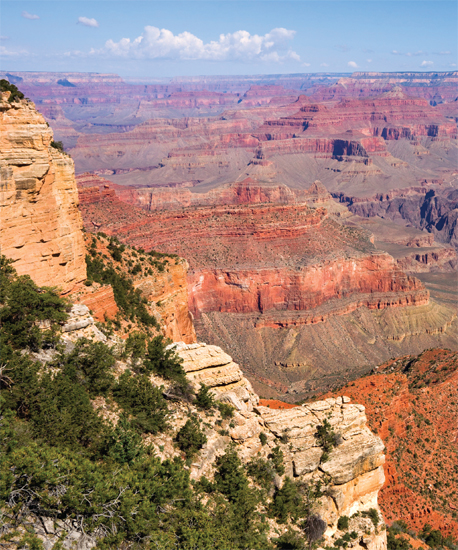
This is a view of the Grand Canyons North Rim in the state of Arizona. This is the highest part of the canyon.
The ancient Greeks and Romans first came up with the idea. They listed the most incredible sights of their time and called them the Seven Wonders of the World. The wonders of the Roman world included statues, a temple, pyramids, and a lighthouse. All were man-made. In those days people, not machines, did the hard labor. Buildings were amazing feats of human power. Most ancient wonders exist today only in stories. Only the Great Pyramid of Egypt, built around 2550 B.C., still stands.
The tradition of listing the Seven Wonders of the World carries on. Unlike the Wonders of the Ancient World, people can claim none of the glory for creating the Wonders of the Natural World. Nature alone carved these sights that we so admire. Over the course of millions of years, rivers flowed over their rocky beds. Slowly the water eroded the stone, carving waterfalls and canyons. Volcanoes and mountains thrust up from the earth in reaction to movement far beneath the ground. Powerful forces of nature shaped the land we know today.
The natural world is a beautiful place. From the ocean shores to the inland forests, there are many little spots of heaven on earth. It is not easy choosing the top seven wonders. Not every person agrees on each selection. Still, some places are unquestionably a touch above all the rest. The worlds tallest mountain, a beautiful harbor, a terrifying volcano, a waterfall, a canyon, a coral reef, and a phenomenon in the night skythese are the seven wonders of the natural world. They are the most magnificent views nature has to offer.
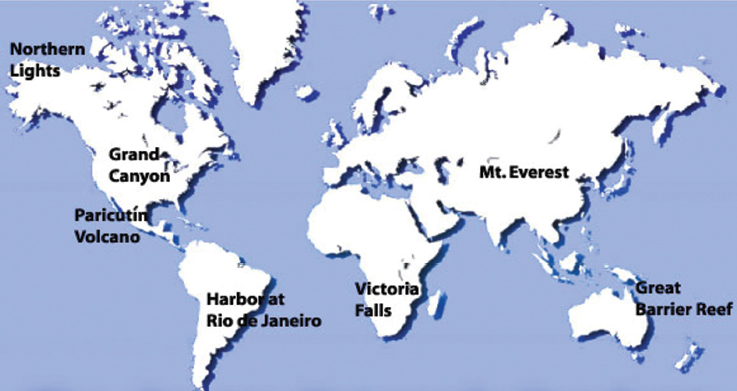
This world map shows where each of the natural wonders are located.
What do these seven eye-catching things have in common? From the thundering Victoria Falls to the mysterious, flickering Northern Lights, the wonders leave humans awestruck. They are so spectacular that people have a hard time comprehending what they are seeing. In times of old, people told myths and legends to explain what they could not understand. By the twenty-first century A.D., scientists had explained away much of the mystery of these wonders. Yet they remain astonishing sights of nature. They are awesome examples of what the forces of nature can accomplish over the course of millions of years.
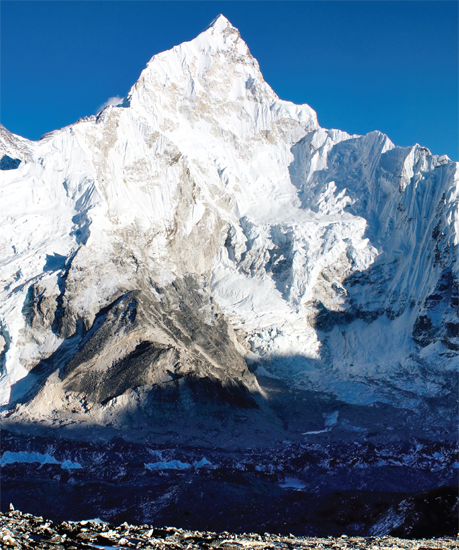
A view of Mount Everest from Kala Patar. Many climbers use Kala Patar as a launch point to begin their trek up Everest.
The lofty and striking Himalayan Mountains is one of the worlds youngest mountain ranges. Their jagged peaks tower above and along the border of Nepal and Tibet, China. The crown jewel of the Himalayas, Mount Everest, stands above them all. Its peak is the highest point on earth. Himalayas is a Sanskrit word that means home of the snow. Sanskrit is an ancient language that originated in the area that is modern-day India. The Khumbu glacier covers Everest in a blanket of white all year long. Rumbling avalanches and the howling wind are the only noises that disrupt the quiet.
Geologists are scientists that study the rocks that form our planet. Geologists discovered that the earths crust is broken into about a dozen large pieces called plates. These huge plates constantly shift and move in reaction to changes deep within the earth. Sometimes plates grind into each other, and sometimes they move apart, creating a rift. Plates can also rub against each other as they move. This process of crust movement is called plate tectonics. Tectonic plates are the building blocks of the earths crust. Both continents and ocean floors sit on top of tectonic plates. Sixty million years ago, India, then a separate continent, crashed into Asia. The collision caused the land to thrust up and form a new mountain range, the Himalayas.
In the mid-1800s, a British survey called the Great Trigonometrical Survey of India mapped the Himalayas. The surveyors discovered a tall mountain they called Peak XV, now known as Mount Everest. They calculated Peak XV had an elevation of 29,002 feet (8,840 meters). They calculated that highest mountain on the planet. Estimates of the mountains elevation varied over the years. The matter was settled in 1998 when an American placed a Global Positioning System (GPS) device on Everests peak. GPS technology uses satellites to map the earths surface. The exact elevation of Mount Everest is now known to be 29,035 feet (8,850 meters), and it continues to grow. Every year the mountain gains a quarter of an inch in height. The colliding tectonic plates, always in motion, continue to drive the Himalayas skyward.
The British named their find after Sir George Everest, a supervisor of the Survey of India. The Tibetans call it Chha-mo-lung-ma, meaning district of the birds. In Nepal, it is called Sagarmatha, or sky head. From the time the Western world discovered Everest, mountain climbers longed to conquer the summit. They wished to experience the thrill of standing on top of the world. Also, if people could climb the worlds highest peak, it would prove we could handle anything. But it was not so easily done. Mount Everest is in a very remote spot and is difficult to reach. Climbers needed permission to climb from the local governments. Both Tibet and Nepal were wary of Westerners. Nepal, for example, had fought a war against Great Britain from 1814 to 1816. Finally, in 1921, the Dalai Lama, the leader of Tibet, agreed to allow in a team of British climbers.
Access to the mountain region was only a small part of the challenge. Now the climbers had to transport tons of gear and supplies. The mountaineers found the help they needed in the Sherpa people of the Khumbu Valley. Originally from Tibet, Sherpas moved to the high mountain regions of Nepal in the 1500s. The expeditions hired Sherpas as guides and porters. Sherpas quickly became known for their skill at climbing in high altitudes. The Sherpas Buddhist religion teaches that the mountains are homes of the gods. Before climbing, Sherpas offer rice and incense to gain the mountains blessing.
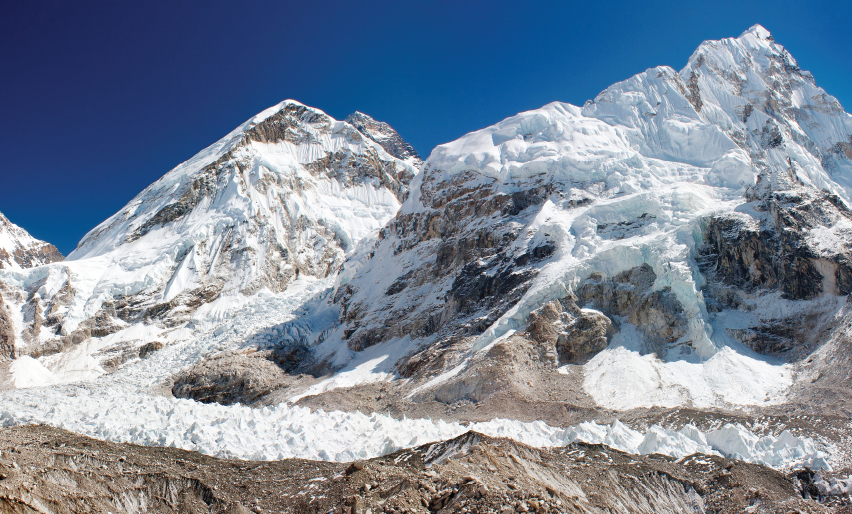
The Khumbu glacier covers Everest in a blanket of white all year long.
On May 29, 1953, New Zealander Edmund Hillary and Sherpa Tenzing Norgay became the first to reach the top. Their success encouraged other climbers. Since 1953, over 1,200 people have stood on top of the world. New records for getting to the top the quickest are set each year. In 1963, the first Americans reached the summit. The first woman to climb Everest was Junko Tabei from Japan in 1975. In 2001, American Erik Weihenmayer became the first blind person on Everest.
Font size:
Interval:
Bookmark:
Similar books «What Are the 7 Wonders of the Natural World?»
Look at similar books to What Are the 7 Wonders of the Natural World?. We have selected literature similar in name and meaning in the hope of providing readers with more options to find new, interesting, not yet read works.
Discussion, reviews of the book What Are the 7 Wonders of the Natural World? and just readers' own opinions. Leave your comments, write what you think about the work, its meaning or the main characters. Specify what exactly you liked and what you didn't like, and why you think so.

